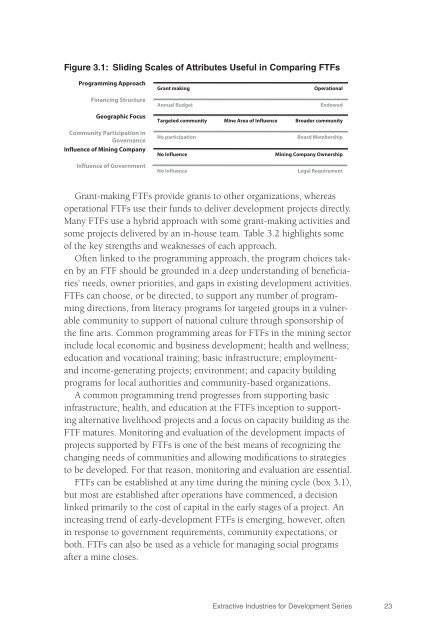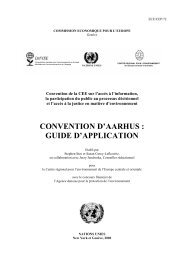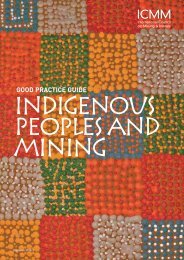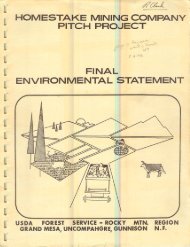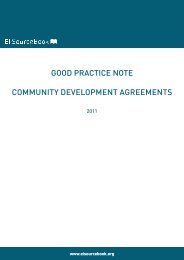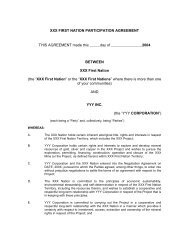Sharing Mining Benefits in Developing Countries - World Bank
Sharing Mining Benefits in Developing Countries - World Bank
Sharing Mining Benefits in Developing Countries - World Bank
You also want an ePaper? Increase the reach of your titles
YUMPU automatically turns print PDFs into web optimized ePapers that Google loves.
Figure 3.1: Slid<strong>in</strong>g Scales of Attributes Useful <strong>in</strong> Compar<strong>in</strong>g FTFsProgramm<strong>in</strong>g ApproachGrant mak<strong>in</strong>gOperationalF<strong>in</strong>anc<strong>in</strong>g StructureAnnual BudgetEndowedGeographic FocusTargeted communityM<strong>in</strong>e Area of InfluenceBroader communityCommunity Participation <strong>in</strong>GovernanceInfluence of <strong>M<strong>in</strong><strong>in</strong>g</strong> CompanyInfluence of GovernmentNo participationNo InfluenceNo InfluenceBoard Membership<strong>M<strong>in</strong><strong>in</strong>g</strong> Company OwnershipLegal RequirementGrant-mak<strong>in</strong>g FTFs provide grants to other organizations, whereasoperational FTFs use their funds to deliver development projects directly.Many FTFs use a hybrid approach with some grant-mak<strong>in</strong>g activities andsome projects delivered by an <strong>in</strong>-house team. Table 3.2 highlights someof the key strengths and weaknesses of each approach.Often l<strong>in</strong>ked to the programm<strong>in</strong>g approach, the program choices takenby an FTF should be grounded <strong>in</strong> a deep understand<strong>in</strong>g of beneficiaries’needs, owner priorities, and gaps <strong>in</strong> exist<strong>in</strong>g development activities.FTFs can choose, or be directed, to support any number of programm<strong>in</strong>gdirections, from literacy programs for targeted groups <strong>in</strong> a vulnerablecommunity to support of national culture through sponsorship ofthe f<strong>in</strong>e arts. Common programm<strong>in</strong>g areas for FTFs <strong>in</strong> the m<strong>in</strong><strong>in</strong>g sector<strong>in</strong>clude local economic and bus<strong>in</strong>ess development; health and wellness;education and vocational tra<strong>in</strong><strong>in</strong>g; basic <strong>in</strong>frastructure; employmentand<strong>in</strong>come-generat<strong>in</strong>g projects; environment; and capacity build<strong>in</strong>gprograms for local authorities and community-based organizations.A common programm<strong>in</strong>g trend progresses from support<strong>in</strong>g basic<strong>in</strong>frastructure, health, and education at the FTF’s <strong>in</strong>ception to support<strong>in</strong>galternative livelihood projects and a focus on capacity build<strong>in</strong>g as theFTF matures. Monitor<strong>in</strong>g and evaluation of the development impacts ofprojects supported by FTFs is one of the best means of recogniz<strong>in</strong>g thechang<strong>in</strong>g needs of communities and allow<strong>in</strong>g modifications to strategiesto be developed. For that reason, monitor<strong>in</strong>g and evaluation are essential.FTFs can be established at any time dur<strong>in</strong>g the m<strong>in</strong><strong>in</strong>g cycle (box 3.1),but most are established after operations have commenced, a decisionl<strong>in</strong>ked primarily to the cost of capital <strong>in</strong> the early stages of a project. An<strong>in</strong>creas<strong>in</strong>g trend of early-development FTFs is emerg<strong>in</strong>g, however, often<strong>in</strong> response to government requirements, community expectations, orboth. FTFs can also be used as a vehicle for manag<strong>in</strong>g social programsafter a m<strong>in</strong>e closes.Extractive Industries for Development Series23


